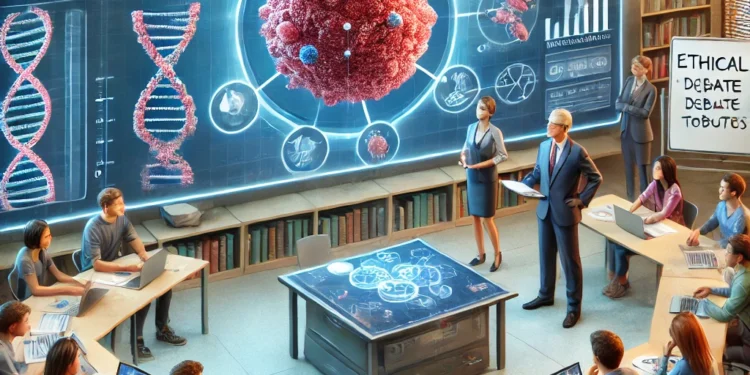Introduction
Problem-Based Learning (PBL) has become a cornerstone of modern education, particularly in fields like medicine and public health. By focusing on real-world challenges, PBL encourages critical thinking, collaboration, and lifelong learning. When it comes to cancer—a disease with profound biological, ethical, and social implications—PBL offers an unparalleled opportunity to deepen understanding while fostering practical problem-solving skills. But what makes a PBL on cancer truly effective?
What Is Problem-Based Learning (PBL)?
Definition of PBL
PBL is a student-centered approach where learners tackle complex, real-world problems in a collaborative setting. Instead of memorizing facts, students actively engage with scenarios that require critical thinking and application of knowledge.
Key Elements of PBL
- Collaboration: Students work in teams to brainstorm and solve problems.
- Self-Directed Learning: Individuals research and bring insights back to the group.
- Facilitator Guidance: Educators serve as mentors, not lecturers.
Benefits of PBL
PBL enhances engagement, improves knowledge retention, and develops problem-solving skills. It’s particularly effective in preparing students for professional environments.
Understanding Cancer: A Multidimensional Challenge
What Is Cancer?
Cancer refers to a group of diseases characterized by abnormal cell growth. These cells can invade nearby tissues and spread to other parts of the body, making it a leading cause of death globally.
Types of Cancer
From breast and lung cancer to rare forms like mesothelioma, each type presents unique challenges and learning opportunities.
Why Cancer Is an Ideal Topic for PBL
Cancer’s complexity makes it perfect for PBL. It spans biology, ethics, and public health, offering interdisciplinary learning opportunities.
Components of a Good PBL on Cancer
Real-World Scenarios
A good PBL uses scenarios like patient cases, ethical dilemmas, or research challenges to mirror real-life complexities.
Multidisciplinary Approach
Effective cancer PBL integrates biology, chemistry, sociology, and ethics, providing a holistic learning experience.
Integration of Technology
Digital tools, such as medical simulations and genomic databases, enrich the PBL process by offering hands-on experiences.
Designing a Good PBL on Cancer
Identifying Learning Objectives
Clearly defined objectives ensure students focus on critical aspects like cancer biology, treatment options, and public health implications.
Structuring PBL Sessions
PBL sessions typically follow these steps:
- Present the problem.
- Identify knowledge gaps.
- Research collaboratively.
- Discuss findings.
- Evaluate solutions.
Assessing Student Outcomes
Use rubrics to assess collaboration, critical thinking, and problem-solving. Regular feedback is crucial.
Key Learning Areas in Cancer-Focused PBL
Biology of Cancer
Explore genetic mutations, tumor development, and the cellular mechanisms underlying cancer.
Cancer Treatments
Discuss chemotherapy, radiation, immunotherapy, and emerging therapies like CRISPR.
Ethical Considerations
Debate issues like patient consent, access to treatment, and medical equity.
Public Health Impact
Examine cancer prevention strategies, from lifestyle changes to vaccination campaigns.
Challenges in Implementing Cancer PBL
Balancing Depth and Accessibility
Educators must ensure the material is challenging yet comprehensible for all students.
Time and Resource Constraints
Developing a comprehensive PBL program can be resource-intensive, requiring careful planning.
Facilitator Training
Educators need training to effectively guide PBL discussions and manage diverse student dynamics.
Case Study: Successful Cancer PBL Program
Overview of the Program
A university implemented a PBL module focusing on breast cancer, combining patient scenarios with ethical and public health discussions.
Key Takeaways
Students reported improved critical thinking, deeper understanding, and a heightened interest in oncology.
Tips for Educators Implementing Cancer PBL
Encourage Collaboration
Foster teamwork through group discussions and joint projects.
Leverage Expert Resources
Invite oncologists and researchers to provide real-world insights.
Provide Ongoing Feedback
Regular feedback helps students refine their learning strategies.
Advantages of Good PBL on Cancer
Fostering Lifelong Learning
Students gain skills that prepare them for continuous learning and professional development.
Inspiring Careers in Medicine and Research
Cancer-focused PBL often inspires students to pursue careers in oncology or public health.
Conclusion
Cancer-focused PBL is an innovative educational tool that prepares students for real-world challenges. By integrating biology, ethics, and public health, it fosters critical thinking and collaboration, laying the groundwork for future medical and scientific advancements.
FAQs
What is PBL, and how does it differ from traditional learning?
PBL emphasizes solving real-world problems collaboratively, unlike traditional methods that focus on rote memorization.
Why is cancer a suitable topic for PBL?
Cancer’s complexity and relevance across disciplines make it ideal for in-depth, interdisciplinary exploration.
How can educators create engaging PBL scenarios on cancer?
Use patient cases, ethical dilemmas, and public health challenges to mirror real-world complexities.
What challenges might arise when using PBL in a classroom setting?
Challenges include balancing content depth, resource limitations, and the need for trained facilitators.
Are there online resources for cancer-focused PBL?
Yes, platforms like PubMed, National Cancer Institute, and medical simulation tools offer valuable resources.

